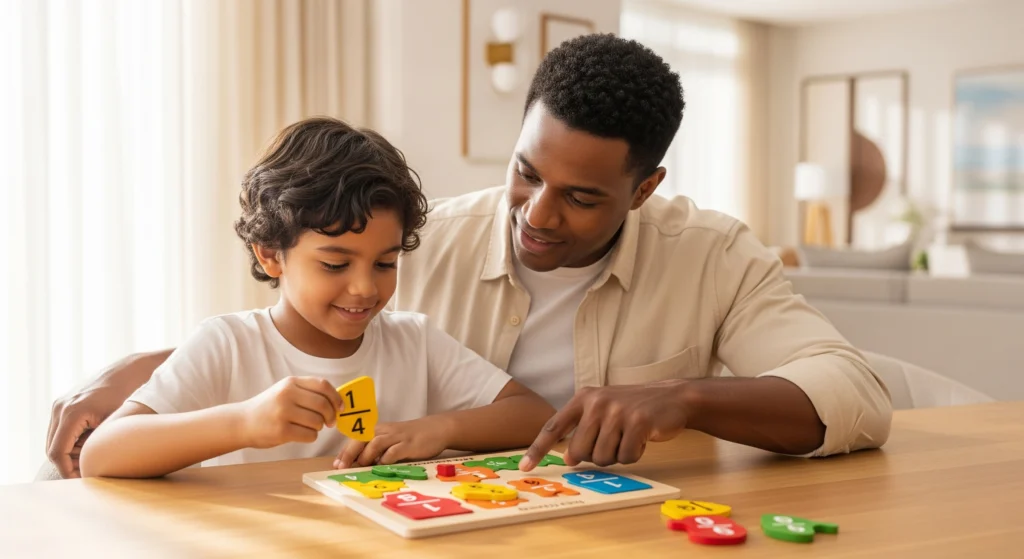The KS1 to KS2 Maths Leap: A Parent's Guide to Supporting Your Child

Introduction: The Biggest Jump in Primary School
As your child waves goodbye to Year 2 and prepares for Year 3, they are standing at the edge of the biggest academic leap of their primary school life: the transition from Key Stage 1 (KS1) to Key Stage 2 (KS2). Nowhere is this jump more pronounced than in Mathematics.
Suddenly, the familiar, hands-on world of counting blocks and simple number lines gives way to more abstract concepts like formal written calculations, multi-step word problems, and the introduction of fractions. For many children, this transition can be a shock, and it’s often the first time a previously confident student begins to feel overwhelmed.
The key is to understand the nature of this leap. This guide will demystify the key mathematical challenges your child will face in KS2 and provide you with simple, practical strategies you can use at home to ensure they make a smooth, successful, and confident transition.
The Shift in Thinking: From Concrete to Abstract
The fundamental difference between KS1 and KS2 maths is the move away from the concrete to the abstract.
In Key Stage 1
Learning is tangible and visual. A child learns that 3 + 2 = 5 by physically combining three blocks with two blocks and counting the total. They are learning the “what” of mathematics.
In Key Stage 2
The expectation shifts. Children are now expected to understand and manipulate numbers and concepts mentally. They need to understand the “why” behind the procedures. This requires a new level of abstract thinking, which is a significant developmental step.
Key Mathematical Challenges in the Leap to KS2
1. Formal Written Methods
While KS1 focuses on mental strategies, KS2 introduces the formal column methods for addition, subtraction, and eventually, long multiplication and division. This
2. The Introduction of Fractions
This is often the single biggest challenge. The idea that a number can represent a part of a whole is a huge conceptual leap. Children will be expected to find fractions of amounts, understand equivalent fractions, and eventually, add and subtract them.
3. Multi-Step Word Problems
The word problems in KS2 are significantly more complex. They often require two or three different steps to solve and demand a high level of reading comprehension to even begin. A child must be able to read a problem, extract the key information, decide on the correct operations, and then perform the calculation.
The abstract nature of these new topics is often where small gaps in a child’s foundational knowledge become apparent. It’s at this point that the focused, one-on-one attention of a specialist British curriculum math tutor can be invaluable in solidifying their understanding.
How to Support Your Child's Transition at Home
You don’t need to be a math expert to help. The best support you can provide is to make maths a fun, positive, and normal part of your family life.
1. Talk About Maths in the Real World
Find the maths in your everyday Dubai life.
Fractions: When you order a pizza, talk about it in fractions. “We’ve eaten 2/8 of the pizza, which is the same as 1/4!”
Measurements: Get them involved in cooking and baking. Measuring ingredients is a fantastic, hands-on way to get comfortable with grams, millilitres, and fractions.
Money: Let them handle the money at the supermarket checkout. Calculating the change is a brilliant mental maths workout.
2. Play Board Games
Classic board games like Monopoly, Snakes and Ladders, and Yahtzee are packed with maths! They involve counting, addition, subtraction, and strategic thinking, all in a fun, low-pressure environment.
3. Focus on "Why" Not Just "How"
When they are doing their homework, ask the magic question: “Can you explain to me how you got that answer?” The act of verbalizing their thought process is a powerful tool for deepening their own understanding.
When to Consider Extra Support
You’ve been playing games and baking pizzas, but you notice your child is still consistently struggling or becoming anxious about their maths homework. The transition to KS2 can often illuminate small but significant gaps from their KS1 learning.
If a child isn’t completely secure with their basic number bonds or place value, they will find column addition and fractions incredibly difficult. Trying to build new knowledge on a shaky foundation is the primary cause of math anxiety.
This is where a tutor’s role is most effective. An expert primary school tutor in Dubai can quickly and accurately diagnose the exact “missing brick” in your child’s foundation. By providing targeted, one-on-one support, they can repair that foundation and give your child the skills and confidence to thrive in KS2.
Conclusion: Building a Bridge to Confidence
The leap from KS1 to KS2 is a major milestone. By understanding the challenges and providing a supportive, positive environment at home, you can build a bridge that helps your child cross it with confidence.
Focus on making maths a normal, fun, and stress-free part of your life. Celebrate their effort, encourage their questions, and you will be nurturing a resilient and capable young mathematician.
If you feel your child needs a stronger bridge to navigate this transition, our experienced British curriculum math tutors are here to build it with them, one concept at a time.